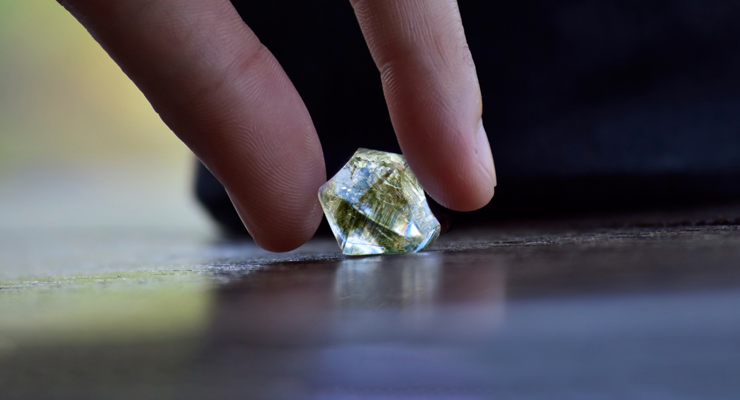Introduction
Diamonds are a girl’s best friend, but what happens when politics gets in the way? The G7 countries have recently imposed sanctions on Russian diamond export. This has consequences not only for Russia but also for India, which heavily relies on the diamond trade. In this blog, we will explore the impact of these sanctions on India’s diamond industry and economy. Firstly, let’s understand why the G7 countries have imposed these sanctions. It is primarily due to the dispute between Russia and Ukraine.
The G7 countries believe that it is Russia’s responsibility to resolve this conflict before normalizing trade relations. As a result, they have imposed sanctions on Russia, which includes a ban on diamond exports. The diamond industry is a significant contributor to Russia’s economy. Russia is a major player in the diamond trade, and these sanctions are set to impact their revenues. It is believed that around 7% of the diamond trade is impacted by the sanctions.
The diamond industry in India is also set to take a hit, as they heavily rely on importing rough diamonds from Russia. This ban on diamond exports from Russia may lead to a shortage of rough diamonds in India, leading to a rise in prices. Indian diamond manufacturers might have to look for alternative sources of diamonds to make up for the loss of Russian imports. Thus, the sanctions could have a severe impact on the Indian diamond industry, which employs millions of people and contributes significantly to the Indian economy. The ripple effect of these sanctions is not only limited to the diamond industry but also impacts India’s economic growth.
India has always maintained a close relationship with Russia, which includes economic ties. The sanctions might make it difficult for India to continue this trade relationship with Russia, which could impact India’s economy. In conclusion, the sanctions imposed on Russia by the G7 countries are set to impact not only the Russian economy but also India’s diamond industry and economic growth. India needs to diversify its diamond trade partnerships to minimise the impact of these sanctions. It is important for India to innovate and develop its own diamond mines to become a global diamond trading hub. But for now, it’s safe to say that diamonds might not be India’s best friend.
History of Diamond Trade between Russia and India

India has a long-standing relationship with Russia in the diamond trade industry. Both countries have a history of diamond mining and have established themselves as leading players in the global diamond market. The diamond trade between India and Russia has grown significantly over the years, with India being the world’s largest diamond cutting and polishing centre and Russia being one of the world’s top producers of diamonds.
India’s diamond imports from Russia have been steady over the years, and in 2013, it was reported that Russia’s Alrosa, the world’s largest diamond producer, supplied around 50% of India’s rough diamond imports. The diamond trade with Russia has been important for India’s economy and has contributed significantly to the country’s GDP. The diamond trade industry provides employment to thousands of skilled and unskilled workers in India, and this has helped boost the country’s economy.
However, the recent sanctions imposed by G7 countries on Russia for diamond exports have had an impact on India’s diamond industry. The sanctions have affected India’s diamond imports from Russia, which has caused a rise in the price of diamonds in India. The sanctions have also had an adverse effect on Indian diamond cutters and manufacturers, as they are heavily dependent on Russia for rough diamonds. Despite the impact of the sanctions on India’s diamond industry, there is a potential for India to diversify its diamond trade partnerships.
India has the opportunity to explore diamond trade partnerships with other countries, which would help reduce its reliance on Russia. The government of India has also been working towards developing its own diamond mines, which would further help reduce its reliance on diamond imports. India has the potential to become a global diamond trading hub, and with the right policies and initiatives, it can achieve this goal. The development of the diamond industry requires innovation and technology.
This would not only help improve the quality of diamonds but also increase efficiency in the diamond manufacturing process. In conclusion, while the sanctions imposed by G7 countries on Russia have affected India’s diamond industry, there is still potential for India to overcome these challenges. The development of the diamond industry requires a strategic approach, and with the right policies and initiatives, India can establish itself as a global diamond trading hub.
Impact of Sanctions on Indian Diamond Industry
The Impact of Sanctions on India’s Diamond Industry The diamond industry in India has long-standing ties with Russia. Industry experts estimate that Russian diamonds contribute around 14 percent of rough diamond imports to India annually. However, with the recent sanctions imposed by G7 countries on Russia, the diamond industry in India is facing uncertainty. Overview of India’s diamond industry India is a global leader in the diamond industry and is responsible for cutting as well as polishing a majority of the world’s diamonds.
The diamond industry in India is a significant contributor to the country’s economy, employing around two million people and accounting for around 7 percent of India’s total merchandise exports. The effect of sanctions on India’s diamond imports and exports The sanctions have led to a significant reduction in Russian diamond exports globally. The diamond trade between Russia and India has not been spared, with experts predicting a severe impact on India’s diamond imports and exports.
The reduction in diamond exports from Russia has led to a shortage of rough diamonds, thereby impacting the production of polished diamonds in the country. Indian diamond cutters and manufacturers are highly dependent on importing rough diamonds from countries like Russia. With the sanctions in place, these exports have been significantly curtailed, leading to an impact on the Indian diamond industry’s supply chain. The sanctions have also led to a decline in diamond prices, impacting the profitability of Indian diamond traders.
The effect of sanctions on Indian diamond cutters and manufacturers The sanctions have led to a significant impact on Indian diamond cutters and manufacturers as they are struggling to source rough diamonds. A reduction in the availability of rough diamonds means that significant manufacturers have reduced their production capacity, which has led to a decrease in the number of jobs in the industry. The sanctions have also led to the increase in the manufacturing cost of diamonds in India.
With the primary source of rough diamonds being disrupted, manufacturers are now forced to source diamonds from other suppliers, leading to an increased cost of production. In conclusion, the sanctions imposed by G7 countries on Russia have led to a significant impact on India’s diamond industry. The reduction in diamond exports from Russia has led to an increase in diamond prices and a shortage of rough diamonds, impacting the supply chain of the Indian diamond industry.
However, the Indian government has already started exploring alternative means of sourcing diamonds from countries like South Africa and Australia. The future of India’s diamond industry remains uncertain, but the use of innovative technology, mining diamonds locally, and exploring trade partnerships with countries other than Russia could be the need of the hour.
Impact of Sanctions on India’s Economy
Overview of India’s economic relations with Russia India and Russia have historically enjoyed strong economic ties, with the diamond industry being a key component of the relationship. Russia has been one of India’s top diamond suppliers, accounting for over 48% of India’s overall diamond imports in 2017. Additionally, India is one of the main markets for Russian diamonds, making up 15-20% of Russia’s diamond exports.
The effect of sanctions on India’s economic growth The G7 countries’ imposed sanctions on Russia have had a significant impact on India’s economic growth. The diamond industry, which accounts for a large portion of India’s exports, has been hit hard by the sanctions. India’s exports of polished diamonds to Russia have decreased significantly since the sanctions were put in place. This has led to a decline in India’s overall exports of diamonds, which has had a ripple effect on the country’s economy.
The potential for India to diversify its diamond trade partnerships In light of the sanctions, it has become increasingly important for India to explore new diamond trade partnerships. India has already begun to diversify its diamond trade, with countries such as Hong Kong and the United Arab Emirates emerging as new players in the market. Additionally, India has been exploring opportunities to source diamonds from African countries such as Botswana, Namibia, and South Africa.
Diversifying its diamond trade partnerships presents India with an opportunity to not only bounce back from the impact of the sanctions but to also emerge as a major player in the global diamond industry. In conclusion, India has been significantly impacted by the G7 countries’ imposed sanctions on Russia. The decline in India’s diamond exports has had a major impact on the country’s overall economic growth. However, there is light at the end of the tunnel. India has the potential to diversify its diamond trade partnerships and emerge as a major player in the global diamond industry. It remains to be seen how the situation will unfold, but India’s resilience and determination will undoubtedly play a key role in its future success.
The Future of Indian Diamond Industry

The Future of India’s Diamond Industry As the world’s largest diamond cutting and polishing centre, India has the potential to become a global diamond trading hub. Until now, India relied heavily on diamond imports from Russia, and the recent sanctions have disrupted this trade. But, given India’s skilled workforce and technology, the country can overcome this challenge and emerge as a major player in the diamond industry.
India has the potential to develop its own diamond mines, which would not only reduce its dependence on imports but also provide a boost to its economy. The government’s efforts to promote domestic diamond mining, supported by private players, can lead to sustainable economic growth and the creation of jobs. However, it requires significant investment and expertise in exploration, extraction, and processing. Innovation and technology can play a crucial role in enhancing India’s diamond industry. The use of advanced technologies, such as artificial intelligence and machine learning, can improve efficiency, reduce costs, and increase productivity.
Moreover, the adoption of sustainable and ethical practices can boost consumer confidence and promote responsible business practices. To achieve these goals, the government must take proactive measures to support the diamond industry. It can provide tax incentives to attract foreign investments, promote research and development, and support the training of skilled workers. Furthermore, the industry can collaborate with academic institutions to develop new technologies and innovations that can revolutionize the diamond industry.
India has a long history of diamond trade and a well-established expertise in diamond cutting and polishing. By leveraging its strengths and investing in its weaknesses, the country can overcome the current challenges and emerge as a key player in the global diamond industry.
Conclusion
In conclusion, the G7 countries’ sanctions on Russia have had a significant impact on India’s diamond industry and economy. India has been heavily reliant on Russia for the supply of rough diamonds, and the imposition of sanctions has disrupted this flow of imports. Additionally, India’s diamond cutters and manufacturers have also been affected by the decline in demand for diamonds due to the pandemic.
Despite these challenges, India has the potential to overcome them. The Indian diamond trade industry can diversify its partnerships and establish trade relations with other countries. India can explore opportunities to develop its own diamond mines and become self-reliant in the supply of diamonds. Furthermore, India has the potential to become a global hub for diamond trading by leveraging its skilled labor force and investing in innovation and technology.
This will enable India to increase its share in the global diamond market and emerge as a significant player. In conclusion, although the sanctions have caused short-term disruption, India can emerge stronger by adapting to the changing market dynamics. It is imperative for India to take necessary steps in diversifying and expanding its diamond trade partnerships and investing in innovation and technology to establish itself as a leading player in the global diamond trade market.
Disclaimer: The views expressed in this blog are for educational purposes only. This is not professional advice. Consult your financial advisor before investing.




